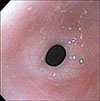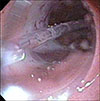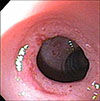Abstract
Congenital antral webs are a rare but relevant cause of gastric outlet obstruction in infants and children. The condition may lead to feeding refusal, vomiting, and poor growth. Due to the relative rarity of the disease, cases of congenital antral web are frequently misdiagnosed or diagnosed with significant delay as physicians favorably pursue diagnoses of pyloric stenosis and gastric ulcer disease, which are more prevalent. We report a case of an eight-month-old female who presented with persistent non-bilious emesis, feeding difficulties, and failure to thrive and was discovered to have an antral web. The web was successfully treated with endoscopic balloon dilation, which resolved her symptoms. Two years later, the patient remains asymptomatic and is thriving with weight at the 75th percentile for her age.
A congenital antral web is a thin mucous membrane that can be found one to two centimeters proximal to the pylorus and can lead to narrowing of the antrum leading to gastric outlet obstruction [1]. It is an uncommon finding with an incidence of 1 in 100,000 births [2]. The exact etiology is unknown, but involves incomplete recanalization of embryonic development during early gestation [2].
Clinical presentation in neonates includes feeding difficulties and recurrent, non-bilious vomiting, while pediatric presentation is more consistent with nausea, early satiety, and epigastric pain [3]. Because of the vague nature of these symptoms, physicians may miss or delay the diagnosis of antral web due to higher suspicion of pyloric stenosis or peptic ulcer disease, which are more prevalent [4]. Reported complications of congenital antral webs include failure to thrive, and rarely, gastric perforation [5].
We present the case of an eight-month-old Hispanic female with feeding refusal, vomiting, and poor growth. Upon presentation, her weight was at the 12th percentile and length was at the 11th percentile for age. Upper gastrointestinal contrast series revealed a congenital antral web. She was evaluated by the pediatric surgeon in Guatemala; however, the family preferred a less invasive approach. Therefore, she was referred to our institution for therapeutic endoscopy.
Upper gastrointestinal endoscopy at our institution revealed a small membranous web in the antrum of the stomach, extending inward from the pylorus. Upon initial endoscopy, an Olympus GIF 160 (Olympus Co., Tokyo, Japan) endoscope with an external diameter of 8.6 mm was inserted atraumatically through a bite block and advanced through the esophagus and into the gastric antrum. Here, a congenital antral web measuring approximately 5 to 6 mm in diameter was identified (Fig. 1). Using a gentle torqueing maneuver, the scope was advanced beyond the web to reveal normal mucosa distally. Withdrawing the scope revealed a significant degree of antral web ablation secondary to the initial scope advancement. Controlled radial expansion balloons (CRE; Boston Scientific, Marlborough, MA, USA) were then used to sequentially dilate the antral web. The balloons were advanced in to the pylorus and gradually expanded first to 9 and 10 mm, then to 11 and 12 mm, then finally to 13.5 and 15 mm for 1 to 2 minutes per session. Upon reaching a diameter of 12 mm, the balloon met resistance and endoscopic visualization through the balloon showed disruption of the mucosa to reveal muscular fibers of the normal pylorus below (Fig. 2). The endoscope was then slowly withdrawn, revealing ablation of the web with no unintended injury (Fig. 3). The patient tolerated the procedure well, and after a period of observation, she was discharged with no significant complications. Upon returning to Guatemala, she underwent a second upper endoscopy with balloon dilation of the pylorus at 13 months of age, from 12 mm up to 15 mm in diameter, without any known complications.
Two years post operatively, follow up revealed continued improved feeding tolerance without recurrence of her symptoms. The patient's weight and height plots also improved from the 11th and 12th percentile respectively at the time of presentation to above the 75th percentile.
Informed patient consent was obtained for publication of the case details.
Antral webs should be considered in the differential diagnosis of infants who present with non-bilious emesis, failure to thrive, and feeding difficulties or in older children who present with nausea, early satiety, and epigastric pain. Though congenital antral webs are less commonly diagnosed than pyloric stenosis or gastric ulcers in these patients, diagnosis can be made using many of the same studies. These include endoscopic imaging or an upper gastrointestinal series, where a characteristic double bulb finding can help confirm the diagnosis [6]. This double bulb finding is caused by an antral chamber that that lies between the web and the pylorus with the presence of a normal appearing duodenal bulb [6].
Once diagnosed, endoscopic balloon dilation and surgical myotomy have both shown efficacy in the management of antral webs [45]. Endoscopic balloon dilation in lieu of surgery can resolve symptoms and result in improved outcomes without further surgical intervention. There are, however, limitations to using endoscopic balloon dilation. While endoscopic balloon dilation is considered a less invasive and viable option in most patients [7], surgical resection remains an important alternative, especially with special anatomic considerations such as an uneven or non-perpendicular mucosal layer or the involvement of vascular structures or muscular layers [2]. Surgery is also a safer alternative in premature infants, particularly those weighing less than 2 kg [2].
In our case, the patient was eight months old and her parents preferred the less invasive approach of endoscopic balloon dilation. Congenital antral webs are a rare but relevant pathology. They are frequently misdiagnosed by physicians in favor of more common conditions such as pyloric stenosis and gastric ulcers. However, antral webs should remain a part of the differential diagnosis in pediatric patients presenting with non-bilious emesis, feeding difficulties and failure to thrive.
Figures and Tables
Fig. 1
Pre-ablation antral web viewed endoscopically. Gray tissue comprised of hypertrophied mucosa narrowing the lumen of the pylorus. Opening measuring 5 to 6 mm in diameter.

Fig. 2
Endoscopic view of antral web ablation. Mucosal tearing is evident by gaps within the gray mucosal tissue revealing dark muscular tissue of the pylorus underneath as viewed endoscopically through the balloon. Serial balloon dilatation using controlled radial expansion balloons (CRE; Boston Scientific, Marlborough, MA, USA) were inserted in the pylorus and gradually expanded first to 9 then to 10 mm, and then to 11 and 12 mm, then a third balloon was used to dilate to 13.5 mm and then finally 15 mm, ranging between 1 to 2 minutes at each session (2 minutes for the final two).

References
1. Noel R, Glock MS, Pranikoff T, Hill ID. Nonobstructive antral web: an unusual cause of excessive crying in an infant. J Pediatr Gastroenterol Nutr. 2000; 31:439–441.

2. Nam S, Koo SH, Chung ML, Jung YJ, Lim YJ. Congenital antral web in premature baby. Pediatr Gastroenterol Hepatol Nutr. 2013; 16:49–52.

3. Lui KW, Wong HF, Wan YL, Hung CF, Ng KK, Tseng JH. Antral web: a rare cause of vomiting in children. Pediatric Surg Int. 2000; 16:424–425.
4. Lu JP, Huang Y, Wu J, Chen SY. Uncommon congenital antral web misdiagnosed twice as pyloric ulcer: successful treatment with endoscopic balloon dilatation. Turk J Pediatr. 2014; 56:100–102.
5. Byun J, Kim HY, Noh SY, Kim SH, Jung SE, Lee SC, et al. Neonatal gastric perforation: a single center experience. World J Gastrointest Surg. 2014; 6:151–155.





 PDF
PDF ePub
ePub Citation
Citation Print
Print



 XML Download
XML Download